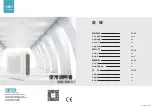
Calculation Example
1
Outdoor unit.
2
Indoor unit.
3
1/2" liquid pipe.
4
1 ⅛" gas pipe.
A, B, C, D
Elbow joints (4)
E
Bends (2)
L = 2 + 3 +3 + 6 + 4 + 7 + 6 = 31
31 < 50 is therefore correct
To calculate the equivalent length of the
interconnection piping and as for the charge loss
calculation, use the data of one of the liquid lines, i.e.
1/2" outer diameter. As can be seen in the diagram,
there are four elbow joints with an equivalent length
of 0,5 m according to the table and two 0,4 m bends
according to the table, to check that the equivalent
length of piping does not exceed the accepted
maximum:
L
E
= 2 + 3 + 3 + 6 + 4 + 7 + 6 + 4·(0.5) + 2·(0.4) = 33.8 m
33.8 < 60 is therefore correct.
Refrigerant charge and piping diameter
Follow the instructions below to add or charge refrigerant to the cooling pipes:
N O T E
The refrigerant charge must be weight-controlled using scales. The refrigerant must be charged in liquid
phase to ensure the components forming it are inserted in the correct proportions.
1. Connect the refrigerant cylinder to the low pressure or gas intake.
2. Open the stopcocks and allow the refrigerant to enter the pipes.
N O T E
Once the refrigerant has been correctly charged, the subcooling temperature (at the expansion valve
inlet) must be approximately 1 °C and the overheating temperature between 5 and 10 °C.
1
2
2 m
3 m
3 m
6 m
4 m
7 m
6 m
A
B
C
D
E
F
3
4
Installation manual
1
Instructions for installation and connection of the unit 1.10
35
Summary of Contents for VCH-25A
Page 4: ...1 Installation manual...
Page 50: ...2 Wiring diagrams...
















































